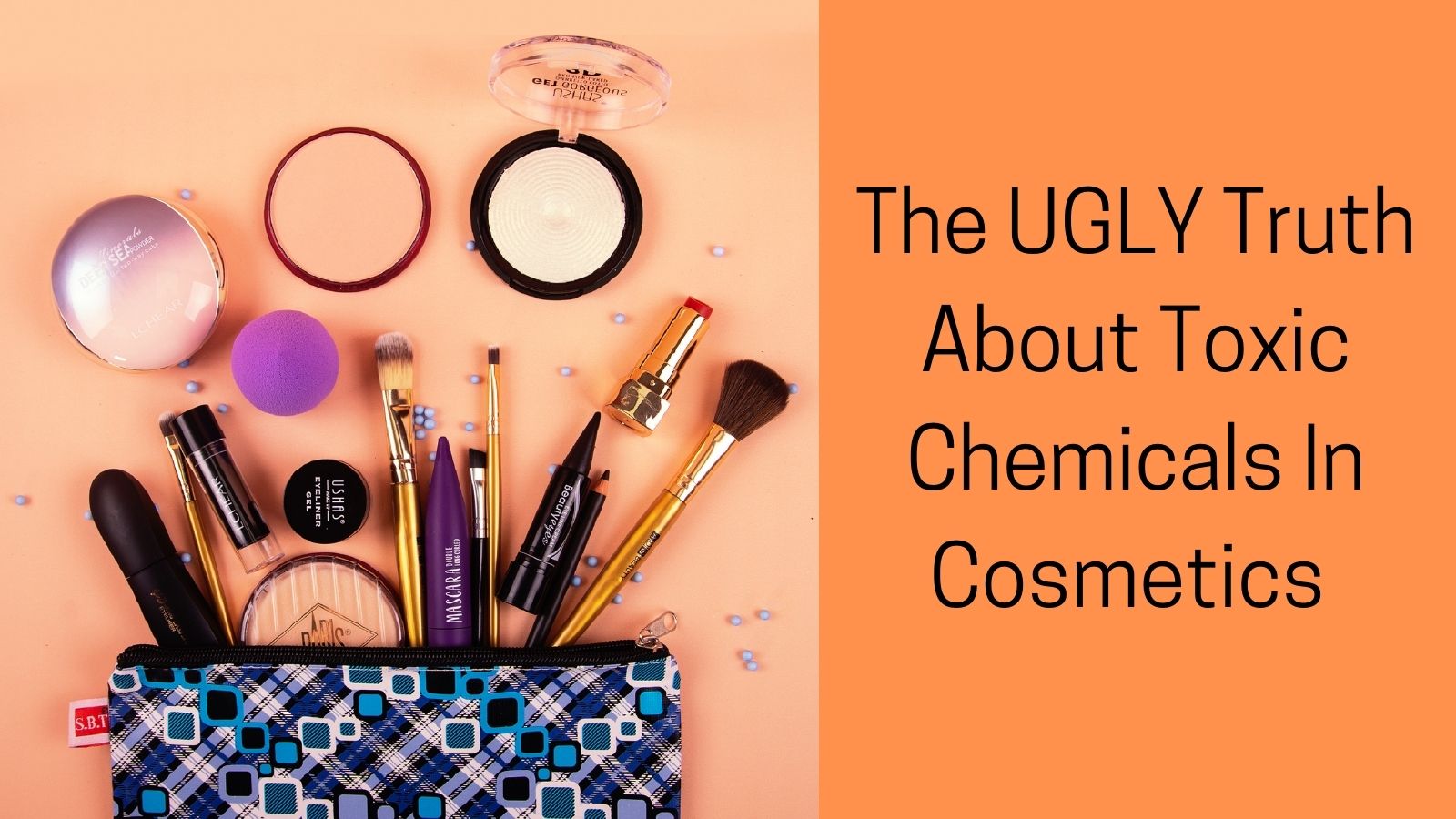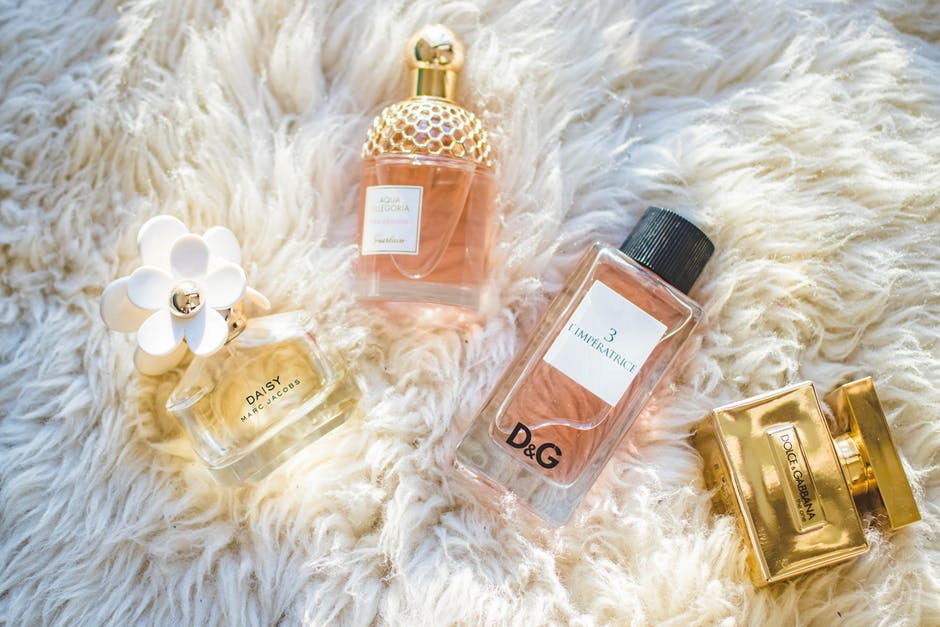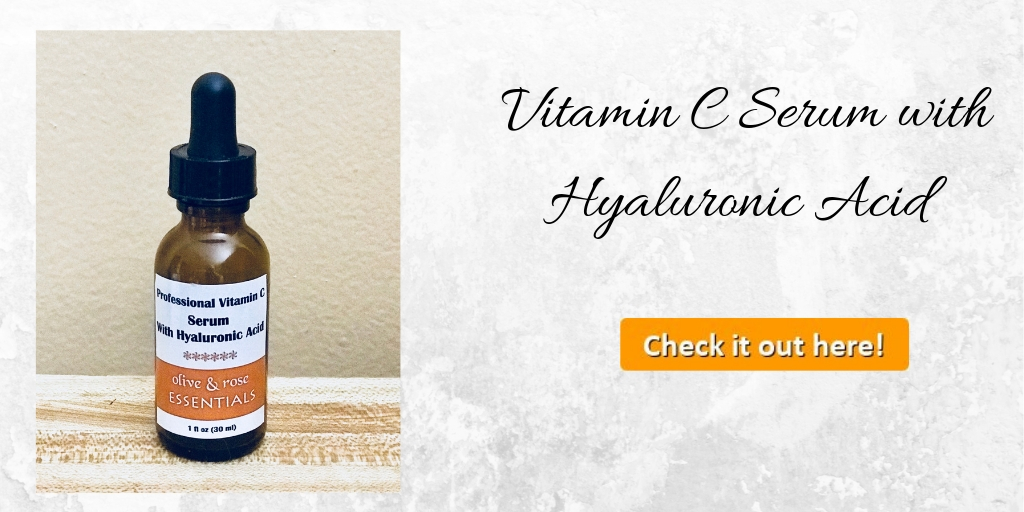We’re swimming in a sea of toxins and slathering them on our skin every single day. There are toxic chemicals in cosmetics you may not be aware of. They’re in your makeup, hair care products, deodorant, skincare creams, and perfumes. Chemicals aren’t regulated and are inexpensive, so it’s really no surprise they’re so widely used.

Toxins can do a number on your health, which is certainly not your aim when you’re strolling the aisles looking for your latest cosmetic fix. This is why it’s vitally important to know which ingredients to steer clear of.
Chemicals applied to the skin are extremely toxic because they absorb through the skin barrier directly into the bloodstream, unlike food that is filtered through the liver. Does your skincare and cosmetics contain any of these toxic ingredients?
Table of Contents
Toxic Chemicals In Cosmetics
1. Formaldehyde
Formaldehyde is a colorless, flammable gas used in the building industry. It’s also used in lotions, shampoos, deodorants, soap, makeup, hair straightening treatments, and nail polish to prevent bacterial contamination. Formaldehyde can cause burns on the scalp, skin irritation, and even hair loss.
Prolonged exposure may also increase cancer risk. To make matters worse, you may not know whether a product contains formaldehyde because “formaldehyde” won’t be listed in the ingredients, but will be listed under the name “formalin,” which is the altered form of formaldehyde when it’s dissolved in water.
Disclaimer: “This post contains affiliate links. I earn on qualifying purchases.”
2. Phthalates
Phthalates are odorless and tasteless chemicals used in hundreds of common products, including soap, hair spray, perfume, nail polish, shampoo, and moisturizers. They’re also in food and are used in the plastic industry in order to make it flexible. Studies on humans are scarce, but animal studies suggest there is a correlation between phthalates and chronic disease.
It’s not typically one chemical that poses a significant problem, it’s when they’re used in combination with other chemicals. Phthalates don’t represent one single chemical, but rather a whole family of chemicals, including DBP, BBP, and DEHP, which incidentally, have been permanently banned from toys. DEHP and DBP have been shown in rat studies to damage the reproductive system.
Phthalates can cause skin irritation and redness, and from research done are rats, are suspected to increase cancer risk. Certain groups are at higher risk for hormonal and reproductive problems, including babies and children, pubescent teens, and women, most likely because women use more personal care products.
3. Sodium Lauryl Sulfate
Sodium lauryl sulfate is an ingredient commonly found in beauty care products, such as shampoo, conditioner, lip balm, foundation, makeup remover, facial cleansers, and liquid hand soap. It’s also used in teeth whitening products, toothpaste, hair-removal products, sunscreen, and bubble bath.
SLS is a surfactant, meaning it reduces the surface tension when used with other ingredients. This makes it an ideal foaming agent. Studies have shown that SLS is not a carcinogen, but is linked to skin, eye, and lung irritation, and may cause premature aging of the skin.
Check out this all-natural foundation formulated with organic ingredients and sun protection, and this naturally-formulated cheek and lip tint.
4. Triclosan
Triclosan was the active ingredient in over-the-counter antibacterials and anti-fungals, including bar soap, body washes, and anti-bacterial liquid hand washes. In 2016, the FDA ruled that products containing triclosan could no longer be marketed to consumers.
Triclosan’s efficacy was found in its ability to prevent bacterial contamination and mildew. However, it is still used in cookware, clothes, and furniture, and has been linked to hormonal disruption, allergies, lowered immunity, antibiotic-resistance, and increased cancer risk.
5. Fragrances
Fragrances are routinely added to cosmetics and personal care products, such as shampoo, shower gels, body lotions, shaving cream, perfume, and cologne. They’re also used in fabric softeners, room fresheners, and laundry detergents. Products sporting the “unscented” label are not necessarily fragrance-free.
Product manufacturers can add a small amount of fragrance in order to mask the smell of other ingredients in the same product, yet the scent is undetectable to the consumer. Cosmetics and skincare containing fragrances have the potential to cause allergic reactions in sensitive people.
6. Oxybenzone
Oxybenzone is an organic compound found in makeup, sunscreen, lip balms, moisturizers, and lipstick due to its ability to absorb ultraviolet rays. It also readily dissolves into creams and lotions. The FDA has deemed its use safe in concentrations up to 6%.
Although, studies are limited, oxybenzone as been linked to endocrine disruption and free-radical production. Safer sunscreen alternatives include titanium dioxide and zinc oxide.

7. Heavy Metals
Heavy metals are pervasive in the environment. They’re in our food and water supply, and unfortunately, are even in products we put on our bodies. Aluminum and lead are known neurotoxins. Aluminum compounds are the active ingredient in antiperspirants and have been linked to cancer.
Lead can be found in sunscreen, nail polish, makeup, eye drops, and lipstick, where it has the potential to cause toxicity. Lead was used in paint until it was banned in 1978 when it was found to cause lead-poisoning. Heavy metal exposure has been linked to neurotoxicity, reproductive problems, immunotoxicity, and cancer.
Groups most vulnerable to exposure include children, teenagers, and pregnant women. The European Union, Japan, and Canada, have banned lead and other heavy metals for use in cosmetics. Their use is only restricted in the United States.
Check out this lead-free, organic lipstick, that comes in eight gorgeous colors.
8. PEG Compounds
PEG compounds are petroleum-based chemicals used in the skincare and cosmetics industry for their humectant, or moisturizing, properties. They’re also used as softeners, solvents, and thickening agents.
PEGS can be found in perfumes, lotions, and toothpaste, and are linked to liver and kidney toxicity, dermatitis, allergies and skin irritation. These compounds are highly toxic because they are contaminated with 1,4-dioxane and ethylene oxide.
The latter is recognized as a neurotoxin and human carcinogen, whereas, 1,4-dioxane is classified as a potential carcinogen. Propylene glycol, a related chemical used in skincare, is used in place of ethylene glycol as an anti-freeze in the automotive industry.
9. Parabens
Parabens are a group of synthetic chemicals used in cosmetics to prevent bacterial, fungal, and mold growth. They’re also used to prolong the shelf life of personal care products. Parabens have been used extensively for decades for their preservative properties, and the fact that they’re inexpensive to use.
They can be found in moisturizers, shampoo, scrubs, tanning products, and makeup. In fact, parabens can be found in the majority of cosmetics.The most common parabens are propylparaben, methylparaben, and butylparaben.
These compounds mimic the activity of estrogen, and have been found in malignant breast tumors. Their use has been linked to both reproductive problems and cancer. Parabens can accumulate and be stored in the body, posing a cumulative risk. Many countries are recognizing the dangers of parabens, with consequent limits on their usage.
10. Mineral Oil
Mineral oil is the left-over liquid from the distillation of gasoline from crude oil. Because it is a byproduct of gasoline, it is cheap and readily available. It has no scent and won’t spoil, both advantageous properties for the cosmetics industry. Mineral oil coats the skin and clogs the pores, impeding the skin from breathing and eliminating toxins.
It also doesn’t absorb well, but once broken down, mineral oil can absorb the fat-soluble vitamins found in the GI tract. This can lead to nutritional deficiencies and is linked to pneumonia. It can also cause hives, rashes, and allergic skin reactions.
Since certain constituents in mineral oil can’t be metabolized, it contributes to overall body toxicity. To make matters worse, mineral oil is a xenoestrogen implicated in endocrine disruption and hormonal imbalances.
Key Points
I find it sobering that so many toxic and carcinogenic chemicals can be found in products that people use on their skin every day. Many of these compounds bio-accumulate in tissue, accentuating their harmful effects.
Protect yourself by carefully reading the ingredient list on every beauty-care product that you buy. The cumulative effects of applying toxic chemicals to your skin every day cannot be underestimated. It’s your long-term health that is at risk.
Does this list of potentially carcinogenic compounds make you want to do your due diligence when purchasing cosmetics? Let me know in the comments:)
References:
(1) American Cancer Society: Formaldehyde
(2) WebMD: What Are Phthalates?
(3) healthline: What is Sodium Lauryl Sulfate (SLS)?
(4) Mayo Clinic: Should I avoid products that contain triclosan?
(5) U.S. Food & Drug Administration: Fragrances in Cosmetics
(6) EWG: Oxybenzone
(7) Campaign for Safe Cosmetics: Lead and Other Heavy Metals
(8) National Cancer Institute: Antiperspirants/Deodorants and Breast Cancer
(9) Real Simple: What Are Parabens – and Do I Need to Worry About Them?
(10) David Suzuki Foundation: The Dirty Dozen: PEG Compounds and their contaminants

Wow! I never knew so much toxic chemicals existed within the cosmetic industry. Doesn’t it seem wrong to put that on your body when natural ingredients exist? The heavy metals seem to scare me the most. I’m going to share this article with my daughter as she wears makeup often. And she’s also socially conscious, but it seems these chemicals get hidden away. Thanks!
Hi JB,
It’s pretty sobering, isn’t it? We’re all adding to our individual toxic loads by the products we buy and use every day. I agree with you, heavy metals are dangerous, and it doesn’t help matters that they’re everywhere. Thanks for sharing my post with your daughter. It’s important to be educated:)
Thank you for sharing this very informative and important article! It’s really scary how there’s dangerous chemicals in everyday products that we use. I knew about some of the heavy metals, especially aluminum since it’s in a lot of deodorants and antiperspirants, as you said.
What has shocked me though is formaldehyde. I had no idea it was flammable and included in deodorants, worst of all is that it’s not listed as one of the main ingredients! I’ve always wondered why these toxic chemicals are allowed to be used in everyday products.
Hi Brian,
Thank you. Bringing awareness to the public about the use of toxic chemicals is an important topic. Heavy metals are pervasive in the environment, adding them to personal care products just adds injury to insult. Aluminum has been linked to Alzheimer’s disease so it’s a serious issue, and it’s unbelievable that they use formaldehyde as an ingredient. Thanks for your comments:)
Holly,
This was a very shocking post for me to read. I wasn’t aware that there are toxic chemicals in cosmetics that could harm our skin. I honestly thought you were joking or something until I read just a little farther. Then I was absolutely horrified.
Why?
Because the very first chemical on your list is formaldehyde. I knew that name instantly. Anyone who has had a loved one or a friend pass should know that name. That’s a chemical that they use to preserve the skin of deceased people. There’s even a story where it was mistakenly used on a woman named Ekaterina Fedyaeva in Russia and resulted in her death.
Hi Donald,
Yes, it’s quite shocking and horrifying that chemicals aren’t regulated and are routinely added to personal care products. What’s added to our food supply is an entirely different issue. Add the two together, and we’re swimming in a sea of toxins.
Formaldehyde is added to cosmetics in its dissolvable form, which is formalin. Oh my goodness, I’ll be looking up Ekaterina Fedyaeva. Unbelievable! Thanks so much for taking the time to leave a comment:)
Thank you so much for sharing such a great article. I have learned a lot of information about toxic chemicals in cosmetics. Why do they even use them in cosmetics if they cause skin irritation. The person will not continue to buy the product.
After reading your article I personally became wary of these issues. I will share your article with my friends so that my friends can be careful about the toxic chemicals that your article discusses.
Thanks for reading. Chemicals are used because they’re generally very inexpensive and readily available. And they do the job they were intended to do, even at a price. It’s true if a product causes irritation for a person, they certainly won’t be buying it again. The truth is, not all people experience reactions. Thanks so much for sharing my article:)
Hi there,
I am so glad you have published such a great article!
I had a horrible experience with a cream that I bought in a cosmetic shop. After putting it on my skin, my face started to swell. My lips and eyes were almost about to blow up. I was disfigured. I ran to the doctor, and he said that it was an allergic reaction to the cream.
I was in shock, and since then, I have never put any cream on my skin except almond oil. Thank you so much for this list. Next time I buy a cream, I’ll check all the ingredients. Thank you for this excellent post and the list of harmful chemicals.
Hi Daniella,
Thank you. Oh gosh, how terrible. I can relate, I had a similar experience with a preservative that was in Aloe Vera juice of all things. My eyes were swollen shut and my cheeks were hot and itchy. It was horrible and it took me awhile to figure out what was causing it. I’m sorry that happened to you.
Chemicals can affect each of us differently, and you may not have any reaction at all, but the chemical can still be toxic. Thanks for taking the time to leave a comment:)